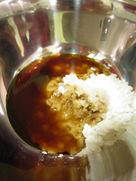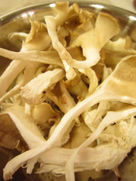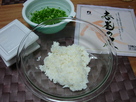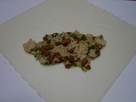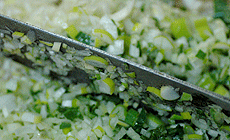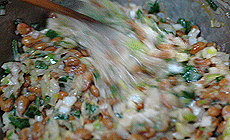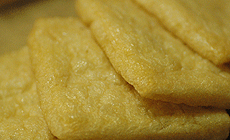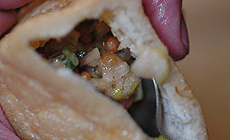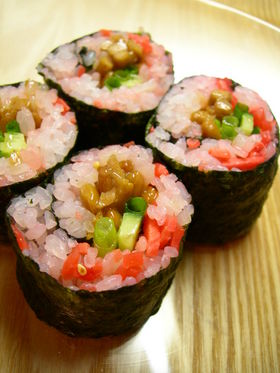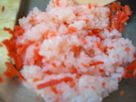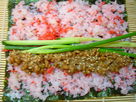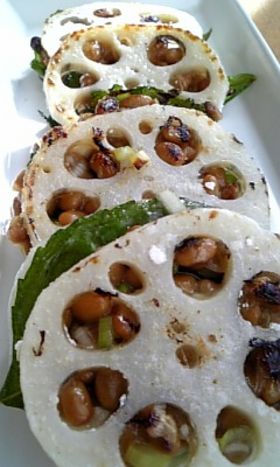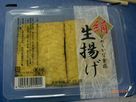VEGAN IMO BURGER
The basic problem for most vegans (and vegetarians) is to find or create food with a sufficien/satisfying “bite”.
Imo or sato imo/taro in this case do provide that satisfactory sensation and can be presented in an appetizing manner for big appetites!
One such simple recipe is Imo Burgers!
INGREDIENTS: for 2~ people
-Sato imo/taro: 7~10 medium-sized
-Cornstarch: 1 tablespoon
-Soy sauce: 1 tablespoon
-Salt: about 1 teaspoon
-Black pepper: as appropriate
-Sweet and sour sauce:
-Water used for boiling the imo: 1 cup/200 cc
-Soy sauce: 2 tablespoons
-Cornstarch: 1 tablespoon
-Sugar: 1 tablespoon
-Fresh ginger juice: ~1 tablespoon
Fresh and tender mushrooms
RECIPE:
Peel and boil taro until you can pass a stick through easily.
Mash the boiled taro in a food processor.
This is how it should look. Don’t worry if somelittle pieces are left.
Transfer into a large bowl and add cornstarch, soy sauc, salt and black pepper.
Mix well with a spatula.
Moisten your hands and form burgers in your preferred shape.
Fry the burgers (on teflon so you don’t need any oil) until they reach a nice color.
Slice some mushrooms (any tender mushrooms are fine).
Add another kind of mushroom shred into strips or ribblens.
Mix the sweet and sour ingredients into a bowl.
Fry the mushrooms in a little oil until they get soft and add sweet and sour sauce and cook until the mushrooms are nice and soft.
——————–
Vegan Japanese Recipe: Burdock, Lotus Root & Carrot Kinpira
There are vast treasures to explore for vegetarians and vegans in Japanese gastronomy.
Once such pleasure (rhyme with treasure) is Kinpira/金平!
Here is a recipe that can be built on at will depending on the available vegetables: Burdock, Lotus Root & Carrot Kinpira/gobou, Renkon to Ninjin no Kinpira/牛蒡・蓮根・人参の金平!
INGREDIENTS: 4 people~
-Burdock root: 1
-Carrot: 1/2
-Lotus root: 4~5 cm long piece
-Grated fresh ginger: 1 teaspoon
-Spices of your choice (include chili pepper!)
–Vegan Dashi: 1 cup
-Sesame oil: 2 teaspoons
-Mirin/sweet Japanese sake: 3 tablespoons
-Soy sauce 1+1/2 Tablespoons.
RECIPE:
-Clean the burdock root under running clear water, cut out in appropriate-sized thin sticks. Drain well. Peel carrot and cut in same size as burdock root. Peel the lotus roots, slice into 5 mm thick pieces, clean in fresh cold water and drain well.
-In a frypan (if possible, non-stick), pour the sesame oil, drop well-drained vegetables and fry.
When the lotu root pieces have started changing color, add dashi, spices of your choice, grated ginger, mirin and soy sauce, and fry on a low fire (10 minutes).
Once the juices have almost reduced stop fire.
Can be served hot, lukewarm or cold!
—————–
Sato Imo Sembei/Taro Crackers
Many people have pressing dietary priorities caused by allergies.
For example wheat flour is a big problem when you want to create bread, cakes or crackers.
Here is a simple suggestion to make crackers with sato imo/里芋/taro.
They should please vegans and vegetarians, too!
Very healthy and tasty!
INGREDIENTS: For 2~3 persons
-Sato imo/taro: 3~4, boiled, peeled and diced
-Soy Sauce: 1 large spoon
-Sugar: 1 large spoon
-Water: 1 large spoon
-Sesame oil: as appropriate
RECIPE:
1- Mash the boiled sato imo/taro. If too hard, soften them inside a microwave oven first.
2-Pour the mashed sato imo in a large bowl. Add soy sauce, sugar and water mix well. For extra taste you can use green tea or oolong tea instead of plain water.
3-Shape the paste into sembei (square, round, oval as you like). Brush sesame oil on both sides and grill them.
Try and press them all the time while they grill! They will taste better!
Easy, ain’t it?
——————————
Vegan Tofu & Macha Tiramisu!
I’m not vegan or vegetarian, but I’m certainly interested, not only for the sake of healthy food, but also for the challenge.
Tiramisu is difficult to imagine for vegans and even vegetarians, but don’t forget that the Japanese are blessed with both tofu for consistent food and macha for extra taste!
Vegan Tofu & Macha Tiramisu!
INGREDIENTS: For 4 people
-Avocado 1 (ripe)
-Tofu/Silk tofu: 125 g
-Soy milk: 60 cc
-Agave Strup: 1.5 tablespoon
-Oatmeal: 70 g
-Vanilla Oil: as appropriate
-Macrobiotic coffee: 1.5 tablespoons
-Powdered macha: as appropriate
RECIPE:
-Mix oatmeal with coffee. Add 1 tablepoon of hot water and mix. It will will turn up as soft cookie when all the liquid has been absorbed..
-Thorw in the cut avocado, tofu, soy milk, agave syrup and vanilla oil into a blender. Mix. Check tatse and add syrup if not sweet enough.
-Line bottom of cup with oatmeal mix.
-Top with avocado cream, Chill inside fridge.
-Top with plenty of macha powder and serve!
Simple, ain’t it!
——————————
Organic French Fries at Uzu/An Interesting Cooking Technique
Service: excellent, easy-going and very friendly
Facilities: great washroom, great cleanliness overall
Prices: very reasonable, good value.
Strong points: Very fresh local ingredients, especially organic vegetables extensively used. Local sake. Home-made umeshu. Great shochu list.
The other day when I visited Uzu with the Missus, I had found the fried potatoes included in the Vegan Oarganic Salad so intriguing that I couldn’t help ordering them separately!
The potatoes are of two kinds:
Pinkish ones called Red Moon and the other yellowish called Inca Mezame.
Both were gron organically by Mr. Matsuki at Bio Farm in Shibakawa Cho in Fujinomiya City at the foot of Mount Fuji.
Now the cooking technique was a bit out of the ordinary:
The potatoes are first steamed whole with their skins.
Instead of slicing them or cutting them into sticks, the potatoes are broken by hand. The potates are chosen small enough to be broken only in two chunks of irregular shape.
They are then deep-fried in high quality oil.
The fact their shape is uneven allows for a bigger outer surface with a lot of crispiness, especially when accounting with the skins!
Having been steamed, the potatoes have acquire the perfect balance of outside crispiness and inside tenderness, but keeping their firmness at the same time, allowing for deep and satisfactory bite!
Do try it!
UZU
Shizuoka City, Otowa-cho, 3-18
Tel.: 054-249-6262
Business hours: 17:00=23:00
Closed on Mondays and first Tuesday
Reservations recommended
Credit cards OK
HOMEPAGE (Japanese)
————————–
Vegan Japanese Cuisine: Tofu, Avocado & Tomato Marinade
Tofu, Avocado & Tomato?
Very much in “season”! Actually could be obtained easily all year round!
Here is a Japanese (and Italian?) inspired vegan (and vegetarian) recipe for the hot days of summer!
Choose your ingredients well, striving for the best and organic, if you can!
INGREDIENTS: For 2~ people
-Tomato: 1
-Avocado: 1
-Tofu: half a standard block~200 g
-Basil: 6 medium leaves
Marinade:
-Olive oil (EV): 2 tablespoons
-Lemon juice: 1.5 tablespoons
-Balsamico vinegar: 1 teaspoon
-Sugar: 1/2 teaspoon
-Salt & black pepper: as appropriate
RECIPE:
-Press water out of tofu (cover it with a clean cloth and a weight on top).
Cut tomatoes, tofu and avocado in same size chunks/cubes (important!).
Think of final look!
-Cut basil in small enough bits for easy mixing.
-Mix all marinade ingredients in a large bowl.
-Add tofu, tomato, avocado and cut basil. Mix delicately. Cover with cellophane paper. Keep in fridge long enough to chill or until you serve.
-Try to be inventive on presentation!
-So easy and yummy!
NOTES:
-Peel skin off tomato if too hard. Choose “fleshy” tomatoes with a little water and seeds as possible. Take the later off if possible.
-Choose a particularly aromatic lemon juice. Meyer would be interesting!
-Keep basil leaves handy for decoration! Mint could be interetsing, too!
———————–
Vegan Japanese Cuisine: Nasu Somen/Egg-plant Somen
I’m neither vegan or vegetarian, but I can tell you that the present scorching weather might convince me to become one! LOL
Egg-plants or aubergines (frankly speaking, I orefer the latter!) are abondant in this season, and they are easily available as organic vegetables, too. There are so many kinds in Jpaan, including Mizu Nasu/Water Aubergines that are eaten raw!
Grilled or fried aubergines are very popular, but there are simpler and healthier ways to prepare them!
Somen/素麺 are very thin noodles that are enjoyed cold/chilled in summer.
Here is a simple recipe just in between: Nasu Somen.
INGREDIENTS & RECIPE:
-Count one long-type aubergine per person.
-Peel the aubergine and cut it in very thin strips with the point of a sharp knife.
-Coat the the aubergine strips with cornstarch.
-Prepare one pan full of hot (just before boiling point) and a large bowl full of icy (leave some cubes of ice in it) water.
-Cook the cornstarch-coated aubergine strips in the pan full of hot water (keep the fire low), a small bunch at a time, and as soon as cooked to satisfaction (should not take long, bu experiment!) transfer into icy water.
-Once the aubergine strips have cooled down completely, transfer into a sieve and drain thoroughly. Place on a serving dish as shown on picture above.
-Use vegan dashi and some light soy sauce or ponzu as sauce. Add a little chili pepper if you like your food hot.
Top with plenty of available sprouts and greens as well as grated ginger. Experiment again! There is no end to delicious variations!
——————————-
Vegan Japanese Cuisine: Daikon & Dried Persimmon Salad
Persimmon can be enjoyed all year round if you dry them.
Now, if you cannot get them on the market, dry them yourself in season next time. It’s not difficult:
Peel them completely, keeping the petal and stem core. Pass a thread through the persimmon and under the stem core. Hang them to dry in the sun (when it rains hang them in dry place).
Preserve them with a sugar coating in a dry box or freeze them!
INGREDIENTS:
-Daikon: 4 cm long cut
-Dried persimmons: 2~3
-Ground sesame seeds/surigoma: 2 tablespoons
-Rice vinegar: 2 tablespoons
-Sugar: 1 and a half tablespoons
-Light soy sauce: a little
-Salt: a pinch
RECIPE:
-Cut the daikon in 2 mm thick, 1×3 cm strips. Massage them with salt and wash them in clear cold water. Drain thoroughly by pressing them inside your hand/fist.
-Cut the stem core out of the dried persimmon. Wash the persimmon with rice vinegar. First cut cut in half, spread and cut in 2=3 mm thick strips.
-Drop the ground sesame seeds in a bowl Add the rice vinegar, sugar, soy sauce and salt (experiment!). Mix well.
If you do not have ground sesame seeds, first grind 2 tablespoons of sesame seeds in a mortar with a pestle until it has turned into a rough paste.
Add the daikon and persimmon. Mix well and serve (themore artistically, the better!LOL)
Add some small leaf greens for the finishing touch!
————————–
Vegan Natto Imperial Rolls
You happen to some steamed (cold) rice leftovers?
Great! You just need (made from rice rice powder or wheat flour) imperial roll wrappers, some natto, thi leeks and soy sauce to make a satisfying and crunchy vegan meal!
Vegan Natto Imperial Rolls!
INGREDIENTS: for 10 rolls
-Imperial roll wrappers: 10 sheets
-Natto: 3 standard packs
-Cold steamed rice (leftovers): 1 large bowl (standard rice ball/experiment!)
-Thin leeks (chopped): 3 tablespoons
-Soy sauce: 1 large spoon
Optional: mustard, hot sesame oil, tare, etc…
RECIPE:
-That’s all you need!
-Mix all ingredients well!
-Place an equal amount of the natto-rice mixture in/on themiddle of an imperial wrapper/sheet and roll.
You know how to do it?
Don’t forget to prepare a little cornstarch dissoled in lukewarm water to seal the rolls!
-Deep-fry in good oil!
Simple again!
———————–
Vegan Yuzu Sherbet
In these hot days of summer, yuzu are abundant and make for simple and great desserts.
Here is a very simple recipe that should please vegans and friends with special needs!
Vegan Yuzu Sherbet!
INGREDIENTS:
-Yuzu: 2 small
-Sufar: 80 g
-Lemon juice: a little
-Warm water: 1 cup/200 cc/ml
RECIPE:
-Grate the skin/zest of the first yuzu. Peel just enough of the skin/zest of the second yuzu and cut into thin thin strips (for decoration).
Press the juice off both yuzu.
-Dissolve the sugar completely in the warm water. Add yuzu juice and a little lemomn juice.
-Let cool completely. Pour ininside a Tupperware and leave inside the freezer for 2 hours. Take out 2~3 times and break and mix around with a spoon.
-When it has reached the wanted state, serve it in a bowl of your choice with yuzu peel and some fresh mint for decoration!
Easy, ain’t it?
———————–
Vegan Japanese Dessert: Yomogi Kintsuba/”Mugwort Sabe Guard”
I visited JA (Japan Agriculture) Agriroad Supermarket in Miwa, Aoi Ku, Shizuoka City this morning. Good exercise, as it is a 40-minute bicycle ride from my home up along the Abe River!
I had the pleasure to meet an old acquaintance, Mrs. Natsuko Koyanagi who works there on Wednesdays.
Actually she is one of the 15 out of a total of over 100 members of Agri Road working in shifts at the JA Agriroad Supermarket. All members are local farmer housewives who decided to form this association with subsidies from the Japan Agriculture Ministry as a “side business” to contribute to their husbands’ earnings. They grow their own food, flowers and cook take-away meals all sold at that supermarket. There are quite a few more in this city, all with a different name, but sharing the same purpose.
her specialty is making “Yomogi kin Tsuba” every Wednesday morning.
And I can tell you these do not stay long as they are freshly made in fornt of the customers who very often make personal orders through the phone early in the morning when she is prparing the batter and the sweetmeats!
Yomogi is mugwort.
Not to be confused with tujone, which was used to make the “Green Fairy”, aka Absinthe, which is now prohibited in its origanl form.
Mugwort grows almost everywhere in Japan and has been used as food and medicinal herb since immemrial times.
It is particularly rich in palmitic acid, oleic acid, linoleic acid, Vitamin A, B1 and B2!
It is particularly popular as tempura and cakes.
It is first crushed and worked into a paste before being mixed with water and flour.
Now, Mrs. Koyanagi uses only “Chikona wheat flour”, that is flour from wheat only grown and ground locally ensuring for the best quality and back tracing.
Moreover, she makes her own anko/sweetmeats with strictly locally-grown azuki beans and sugar.
Nothing else! I can assure you that vegans couls feed on them all day!LOL
Now, why the name “kintsuba”?
Kintsuba means sword guard. It has three openings, the middle one for the blade, the other two for the pins to secure the same blade and guard together.
As explained above, Mrs. Koyanagi prepares her own batter to a sticky paste, solid enough to be able to wrap it around a ball of anko.
She will then drop the cake on a hot plate (coated with a little oil) and press it with her three middle fingers so as to attain the shape of a sword guard!
Important note: Mrs. Koyanagai wears medical gloves during the whole operation.
Actually, one more reason she makes these cakes is because she receives the visit of many Nepalese through her charity work abroad. As her Asian friends are most of the time strict vegetarians, it becomes a double pleasure for her to feed them!
Incidentally, yomogi kintsuba was a very popular cake with the samurais of old times!
—————————
Vegan Japanese Yama Imo Salad
Yama Imo is Yam in English.
As said many a time before, it is a very healthy vegetable.
The Japanese often eat it raw in salads or as an appetizer.
Here is a very simple suggestion for vegans, vegetarians and omnivores alike!
Great with beer or Japanese sake!
INGREDIENTS:
-Yama Imo/Yam: 1/4
-Ooba/Large shiso/perilla leaves (if not available, use perilla leaves): 3~4
-Soy sauce: of your choice and as appropriate. (can be replaced with ponzu)
-Wasabi: grated as appropriate.
RECIPE:
-Peel yama imo.
Cut it in 5~7 cm-long and 1/2cm wide strips/sticks.
If you find cutting it raw diificult, freeze it first, then cut. It will re-attain its original state very quickly.
-On a serving dish, make a bed of leaves.
Place yama imo sticks as shown on pics.
-For the sauce, you can either mix the soy sauce (or ponzu) with the grated wasabi and serve it in small dish for dipping if you use chopsticks.
If you use a fork, pour the sauce over the yam imo.
Note: I use sprinkle the yama imo with plenty of roasted sesame seeds for extra taste and crunch!
————————-
Vegan Japanese Cuisine: Aburaage & Spring Cabbage Rolls with Wasabi Sweet & Sour Dressing
Spring in Japan sees frsh and almost cabbages on the markets. These cabbages are so tender that they can eaten raw in many fashions!
Rolling them in aburaage/deep-fried tofu pouches is an excellent recipe for vegans and any priorities!
Wasabi is a local product in Shizuoka (80% of the total Japanese production) and is so valuable both for the extra zip and medicinal values!
Aburaage & Spring Cabbage Rolls with Wasabi Sweet & Sour Dressing
INGREDIENTS: For 4 rolls
-New (Spring) cabbage: 4 leaves
-Aburaage: 2
-Carrot: 70 g
-Water: 250 cc/ml
-Soy sauce: 1 tablespoon
-Japanese sake 1 tablespoon
-Mirin/Sweet sake: 1/2 tablespoon
-Dashi: 1/2 tablespoon (Check Vegan Dashi Recipe)
-Cornstarch: a little dissolved in water
-Wasabi: 1/2 teaspoon (grated)
RECIPE:
-Cut out the middle stringy core off the cabbage leaves. Wash them in clear cold water, taking care not to break them. Lay on a tray and cover with cellophane paper. Cook in a microwave oven for 3~4 minutes.
-Cut the carrot into thin 6 sticks in a length equal to that of the aburaage and 1 cm square thick. Lay on a tray, sprinkle with a little water and cook in icrowave oven for 2 minutes.
-Cut the aburaage in halves along their length and open.
-Drain the cabbage well and sponge off any water with kitchen paper.
Put two leaves each on top of each other and cut edges as to leave enough cabbage surface to be slightly wider than the aburaage.
-Lay the open aburaage on top of the cabbage leaves. Lay the carrot sticks on top of the aburaage from the inside edge. Roll the lot away from you with a firm hand. Keep aside.
-In a pan just large enough to contain two cabbage rolls drop in the water, Japanese sake, mirin and dashi. Heat and place the rolls inside “heads up”.
-Cover the whole with foil paper. Put the lid on top and food on a low fire for 10 minutes.
-Turn the cabbage rolls over and cook for 10 more minutes.
-Take the two rolls out and cut each into two equal halves. Place on a serving dish.
-Heat and check the taste of the soup and adjust if necessary. Add the wasabi and mix well.
-Add some cornstarch dissolved in water and stir until syrupy. Pour the sweet and sour wasabi dressing on the rolls. Topp with some chopped green leaves and serve.
Vegan Japanese Cuisine: Natto no Age Yaki
My French Friend in Osaka has already extensively written about such recipes, so the present recipe is more a confirmation than an innovation!
It is very popular in Japan, probably more in my region, Shizuoka and Kanto, than in the western part of Japan including Osaka!
First of all, choose some good fresh thin leeks and use a lot for your Vitamin C, fibers and other useful nutrients. Chop them fine and drop them in a bowl.
Add the natto to the leeks. I also add a little light taste soy sauce, a little sesame oil, a little mustard and some chili pepper for additional zip. But this seasoning is entirely up to your preferences and priorities.
Mix well! It must form a really sticky mass.
Aburaage: deep-fried tofu pouches.
If you make them yourself, great!
If you van buy them freshly made at the market, great again!
Now, if you buy them packed, they either come as they are or in brine.
If in brine, throw the brine away and sponge the aburaage of between sheets of kitchen paper.
Cut each aburaage in half, or cut off one “tail” only to form a larger pouch.
With a sharp knife, “open” the aburaage so as to form a pouch.
Fill the pouch with the natto nixture.
“Lock” the pouch with a wooden toothpick as shown on the picture.
Fry on a frypan without any oil (plenty left inside the pouch), unless you are using aburaage preserved in brine.
Fry to a crispy broan colour.
Cut or serve as it is (look at top picture!) with some freshly grated ginger and some ponzu!
—————————
Vegan Natto & Cucumber Sushi Rolls
Here is another simple suggestion for making sushi rolls with natto for all to enjoy!
Vegan Natto & Cucumber Sushi Rolls!
INGREDIENTS: For 1 roll
-Nori/dry seaweed sheet: 1
-Rice: 1 bowl Check RECIPE
-Roasted sesame seeds: 1 teaspoon
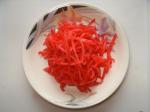
-Beni shooga/pickle red ginger: 1 tablespoon
-Natto: 1 standard pack
-Cucumber (Japanese style, thin and crunchy): 1/2
-Thin leeks: 1~2
RECIPE:
-Chop the beni shooga finely. Add to rice with sesame seeds. Mix well.
Cut the cucumber into long thin strips.
Do the same with the leek.
Mix natto with its seasoning well (if not sold together, use soy sauce, sesame oil and mustard).
On a sushi roll pad, spred the nori/dry seaweed sheet. Cover it evenly with the rice.
As shown in picture above, fill the roll (starting fromabout 1 quarter of the width) with cucumber, leeks and natto.
Roll delicately first, then firmly.
Leave inside the pad until you serve.
Before serving, unroll the sushi roll and cut it with a sharp knife.
Wipe the knife cleanly after each cut!
Enjoy!
————————-
Vegan Japanese Cuisine: Lotus Root and Natto Sandwiches
I still have plenty of recipes with natto to publish!
This time I would like to introduce a very simple idea for a cruchy snack (Bazooka Gourmet will certainly have a comment for that! LOL):
Lotus Root and Natto Sandwiches!
INGREDIENTS: For 4 people
-Lotus root/Renkon: 20 cm long piece or the equivalent in 2 or 3 roots
-Natto: 1 standard pack
-Ooba/large shiso leaves/perilla leaves: 1 for each sandwich!
-Leek: as appropriate (chopped)
-Cornstarch: as appropriate
-Soy sauce: as appropriate
RECIPE:
-Cut the lotus root into 5 mm/1/2 cm thick slices. Wash in clear cold water.
Mix the natto with the chopped leeks and the tare/sauce and mustard provided in usual packs (if unavailable add some soy sauce, sesame oil and mustard).
Wash the large perilla leaves in clear cold water.
-Take water off both sides of lotus root slices with kitchen paper. Do the same with perilla leaves. Sprinkle lotus root slices with cornstarch on one side only, that is the side which will come in contact with frypan and oil.
Make sandwiches with one slice of lotus root + one perilla leaf + natto mix + one more lotus root slice.
Pour a little oil of your liking in a frypan and fry snadwiches on both sides until the lotus root is cooked and has attained a nice colour.
-Serve with a light soy sauce and yuzu kosho/lime and pepper paste for extra seasoning!
-Enjoy with a beer!
————————–
Natto Manofu!
Mabodofu in Japanese or Mapo Doufu in Chinese Mapo doufu, is a popular Chinese dish from the Sichuan (Szechuan) province. It is a combination of tofu (bean curd) set in a spicy chili- and bean-based sauce, typically a thin, oily, and bright red suspension, and often topped with minced meat, usually pork or beef. Variations exist with other ingredients such as water chestnuts, onions, other vegetables, or wood ear fungus, but these are rarely considered authentic Sichuanese.
The Japanese sometimes combine it with natto to create a vegan recipe!
Natto Manofu!
INGREDIENTS: For 2~ people
-Natto: 2 standard packs
-Tofu (silk to fu): 1 standard block/300~400 g
-Leek: 1/2 finely chpped
-Fresh ginger: 3×3 cm cube, finely chopped
-Garlic: 1 clove, finely chopped
-Salad oil or seasme oil: as appropriate
-Soy sauce: 1 tablespoon
-Mirin/Sweet sake: 1 tablespoon
-Japanese sake: 1 tablespoon
-Doubanjiang/豆板醤: 1 tablespoon
-Shichuan pepper (if a vailable): a little
RECIPE:
-Mix the natto with its tare/sauce. If tare is not provided, mix it with 2 tablespoons of soy sauce. Press water out of tofu. Cut tofu into small pieces (size of the pieces is up to your preference actually!).
-In a bowl mix soy sauce, Japanese, mirin and Doubanjiang into seasoning sauce. Set apart.
-Heat oil in a frypan. Throw in the chopped leek, ginger and garlic. Stir fry for a while.
-Once the leek have become half transparent throw in natto and the seasoning sauce. Mix and heat quickly for a short while.
-Add tofu, Fry until natto has mixed with tofu.
-If there is not enough water to your preference, add some hot (not cold!) water. Sprinkle with Shichuan pepper and serve atop freshly steamed plain rice!
————————-
Vegan Natto & Aburage Tofu
Tofu and natto are both made from soy beans and can be easily combined into vegan recipes!
Natto & Aburage Tofu!
If you have any problems with quantities, look at pics or experiment!
INGREDIENTS: For 2 people
-Abrage/deep-fried tofu: 1 standard pack/2 blocks
-Natto: 1/2 standard pack
-Natto tare/sauce/dresing (sold with pack): as appropriate
-Miso: 2 tablespoons
-Leek: 1/2 chopped
-Soy sauce: as appropriate
RECIPE:
-Sponge water the oil and humidity off the aburage with some kitchen apaper. Cut through as to be able to open and stuff the tofu. The best method is to cut at an angle as shown in above picture, leaving half closed. Actually, you had better experiment, although you must keep in mind that the tofu should not be completely cut!
-Add some chopped leeks and the tare/sauce to the natto and stir until sticky. Add remaing chopped leeks and stir well.
-Paste the inside of the tofu with miso. Use a spoon. Stuff each tofu block with half of the natto. Secure with a toothpick.
-Fry until tofu attains a nice toast colour. No need to use oil!
You can also grill inthe toaster!
-Cut to size of your preference or serve it whole. Provide soy sauce for more seasoning if needed.
-Aburage as sold packed in Japan, although you will find them freshly made at any good large supermarket here!
———————–
Vegan Japanese Cuisine: Ko Imo No Nimono
In Jpanese Ko Imo/小芋 means small taro tubers, and Nimono/煮物 can be loosely translated as stew.
Imo are great for vegans as they are fulfilling and so healthy!
Ko Imo No Nimono: Small Taro Tubers Stew
INGREDIENTS: For up to 3 people
-Ko Imo/small taro tubers: 15
-Vegan Dashi: 1 cup/200 cc/ml. Check RECIPE.
-Mirin/Sweet sake: 1 tablespoon
-Japanese sake: 3 tablespoons
-Salt: a little less than 1/2 teaspoon
-Sugar: 1 large tablespoon
-Light soy sauce: 1/2 tablespoon
-Fresh string beans: as many as you want
-Yuzu/Lime
RECIPE:
-Wash the the ko imo/taro tubers throroughly. Cut off both hands and peel “straight” so as to form six distinct sides. Was in clear running water and drain.
-Drop the imo in a large pot and cover completely with water. add a little rice (it will add taste). Cook until you can pass a wooden skewer through the imo.
-Bring the pot at a slant under the water tap and let the cold water flow into the pot and out with the hot water. This simple techenique will get the imo rid of unwanted stickiness. Throw all water out, but keep the imo inside the pot.
-Pour all the sauce ingredients onto the imo. Switch on fire and simmer the imo over a weak fire long enough for the imo to “suck in” the sauce.
-Cut the extremeities off the string beans and boil in salted water until tender enough. The Japanese like them only lightly boiled and crispy.
-Let imo and string beans cool completely. Transfer the string beans with the imo. Chill if necessary.
-Serve in a dish as shown on picture above and press some lime/yuzu over it!
——————–
Red Miso Dip Sauce
This posting has also been prompted by my new friend, Maggie Lam, who wanted to get some information for a red miso dipping sauce.
It is only a suggestion open to infinite variations!
INGREDIENTS: For 2~3 people
-Japanese sake (if inavailable, replace with dry white wine): 1 tablespoon
-Red miso: 2 tablespoons
-Sugar: 1 tablespoons
-Ground sesame seeds: 1 tablespoon
-Oyster sauce (vegan and vegetarians can replace it with soy sauce): 1 teaspoon
-Sesame oil: 1 teaspoon
RECIPE:
-In a small pan, heat the Japanese sake to have the alcohol evaporate. Do not boil. Add all other ingredients and mix well.
-Let cool completely before using it.
NOTES:
This sauce is especially welcome in summer.
Combine white miso withe red miso for a different colour and taste!
If consumed by adults only, use chili pepper sesame oil!
———————–
Red miso Dressing
This posting has been prompted by my new friend, Maggie Lam, who wanted to get some information for a red miso dipping sauce.
Although this particular recipe is more a dressing than anything else, it could be used as a dipping sauce if you mixed in fresh cream. Th cream will solidify when combined with oil.
Unfortunately it will not qualify as a vegan recipe.
I wonder if soy milk cream exists!
INGREDIENTS:: for 60 ml/cc of dressing
-Red miso: 1.5 tablespoons
-Soy sauce: 1/2 tablespoon
-Rice vinegar: 1.5 tablespoons
-Sugar: 1 tablespoon
-Salad oil of your choice: 3 tablespoons
-Ground sesame seeds: 1.5 tablespoons
-Freshly grated ginger: a little
-Freshly grated garlic: a little
RECIPE:
-First mix miso, soy sauce, sugar, ground sesame, grated ginger and garlic until you obtain a smooth mixture. Add oil and rice vinegar and stir well.
-Serve it onfresh vegetables and tofu salad!
-Great for taste and look on freshly boiled or steamed vegetables!
————————
Vegan Edamame Tofu
This is the season for fresh edamame and there are so many ways to accomodate them!
Have you ever thought of creating a vegan recipe with them and tofu.
Here is a simple way to please everyone!
Vegan Edamame Tofu!
INGREDIENTS: For about 6 people, unless you have a big appetite!
-Kinu Tofu/Silk Tofu: 400 g
-Edamame: 1 cup (boiled in salted water and extracted from their pods)
-Agar agar: 8g
-Water: 385 CC/about 2 cups
-Salt: 1/2 teaspoon
-Mirin/sweet sake: 1 tablespoon
-Vegan konbu dashi/seaweed soupstock: Check RECIPE: 1 cup/200 cc/ml
-Mirin/sweet sake: 3 tablespoons
-Soy sauce: 3 tablespoons
-Grated wasabi: as appropriate
RECIPE:
-Soak the agar agar in the water for at least two hours or overnight.
-Peel off the thin skin of each edamame. Borin work, I must admit, but worth it!
-Place the tofu over a bamboo strainer/zaru to take as much water off as possible.
Press the agar agar strongly to drain it of any water.
Drop the agar agra in 400 cc of water and simmer on a weak fire until completely dissolved.
-Drop the edamame, tofu, salt and mirin in a mixer/food processor.
Turn until you attain a smooth paste.
-In a large bowl pour the tofu mixture and add the dissolved agar agar a lttle at a time and mix well until all has been incorporated.
Pour the whole into a rectangular mold you will have wetted beforehand.
-Smooth the surface flat with a gum spatula. Knock down the mold on the working table a few times to ensure homogeneousity.
Let cool and place inside refrigerator.
-Mix the dashi, soy sauce and mirin/sweet sake.
Heat to just before boiling point. Switch off fire and let cool completely.
Keep in thefridge.
-Turn the edamame to fu over a cutting board.
Cut into 8 pieces and place them on serving dish as shown above.
Pour dashi drssing around it.
Decorate with a few edamame and some grated wasabi.
Enjoy!
———————-
Vegan Tofu Fruit Cake
If you have tofu and flour on hand, you do not need eggs or milk to make a tasty cake!
INGREDIENTS: For a pound cake-sized mold
-Tofu: 120 g
-Maple syrup: 80 g
-Oil: 20 g
-Cake flour: 100 g (wheat flour allergics could use another type of flour or rice flour)
-Baking soda: 2cc/ml
-Walnutes: 50 g
-Dried prunes: 50 g
RECIPE:
-Let rest the tofu over a plate with small holes or a strainer (“Zaru” in Japanese) for at least 10 minutes to get rid of some water.
Drop into a bowl. Add the maple syrup and oil. Mix well with a hand mixer.
-Thieve the flour and baking soda over the tofu. Add the (cut for size if needed) walnuts and prunes. Mix well with a spatula.
-Line a mold with baking paper.
Pour in the cake mixture.
Bake at 180 degrees Celsius for 30 minutes.
NOTES:
-One can use sweet potatoes instead of the dried fruit. Cook them in microwave until soft first.
One can use apple sauce/jam instead of maple syrup.
Some jellied orange peels could alos add a nice finishing note!
———————-
SPRING ONIONS WITH SESAME & MISO DRESSING
Shizuoka Prefecture is famed in Japan for producing the first new onions of the year.
They are very soft and sweet and are much appreciated steamed with a simple seasoning.
If you can grab these onions in your own country or hometown, here is a simple recipe that please everyone!
Spring Onion with Sesame & Miso Dressing!
INGREDIENTS: For 2 people
-New Spring Onions: 2
-White sesame seeds: 1 tablespoon
-Sugar (of your preference): 1 teaspoon
-Soy sauce (of your preference): 1 teaspoon
-Miso paste (of your preference): 1 teaspoon
-Mirin/sweet Japanese sake: 1 teaspoon
RECIPE:
In a mortar (“suribashi” in Japanese) drop the white sesame and grind thoroughly with a pestle. Add the sugar, soy sauce, miso paste and mirin.
Mix well.
-Peel the onions. Cut off the pointed tip. Cut through into four quarters down to 9 tenths of its height (do not cut completely as it must “stands” on its own!).
Place each onion on/in its serving dish (preferably earthenware) and wrap with cellophane paper. Cook in the microwave oven long enough for the onions to become soft. This shouldn’t take long if the onions are new. This method will ensure that nothing “escapes” from the onions!
-Pour the seasoning over the onions and serve!
POINT:
-Grinding your own sesame seeds will provide for a better and deeper taste than using ready-ground sesame seeds!




